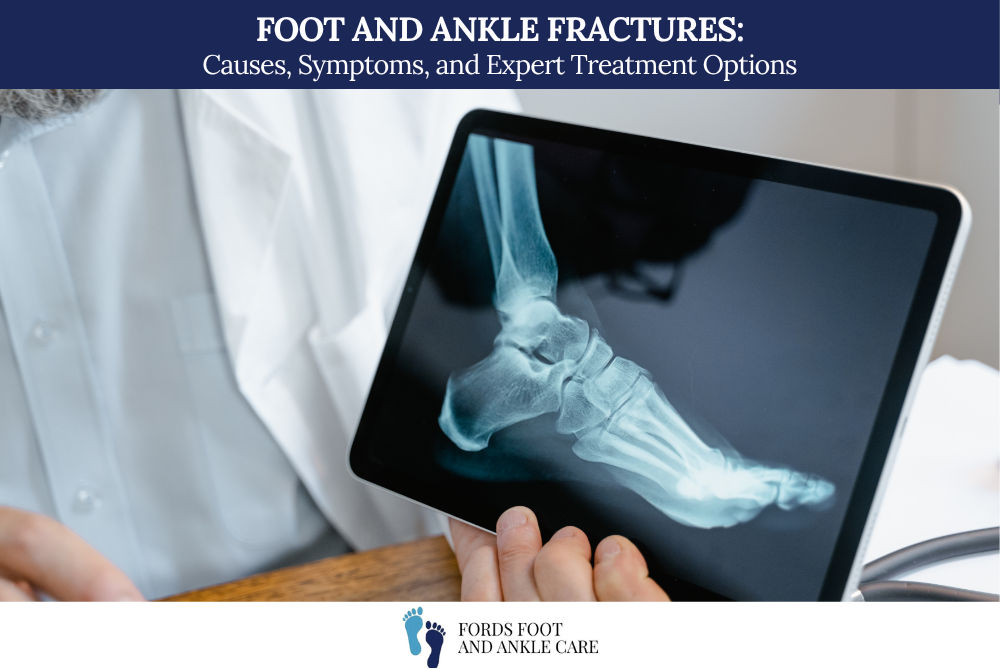By Fords Foot and Ankle Care
Fords, NJ | Comprehensive Podiatric Care
Foot and ankle fractures are among the most common injuries treated in podiatry and orthopedics. Whether caused by trauma, sports injuries, or repetitive stress, fractures in the lower extremities can significantly impact your mobility and quality of life. At Fords Foot and Ankle Care, we specialize in diagnosing and treating all types of foot and ankle fractures—from simple stress fractures to complex displaced breaks—with compassion and expertise.
This blog post will help you understand the types of fractures, their causes, symptoms to watch for, and the advanced treatment options available at our clinic in Fords, New Jersey.
What Is a Foot or Ankle Fracture?
A fracture refers to a break in the bone. In the foot and ankle, there are 26 bones, all of which can be fractured under various conditions. Fractures range from small cracks (known as stress fractures) to full breaks that may involve displacement or misalignment of the bone.
Common Causes of Foot and Ankle Fractures
- Direct trauma (e.g., car accidents or heavy object falls)
- Sports injuries (especially in runners, dancers, or contact sports athletes)
- Twisting injuries (commonly lead to ankle fractures)
- Falls or missteps
- Overuse or repetitive motion (leading to stress fractures)
Signs and Symptoms of a Fracture
- Sudden, sharp pain at the site of injury
- Swelling and bruising
- Inability to bear weight or walk
- Visible deformity in severe cases
- Tenderness to touch
- A “cracking” or “popping” sound at the time of injury
If you’re experiencing any of the symptoms above, it is important to seek prompt medical evaluation. Delaying treatment can lead to long-term complications like improper bone healing or chronic pain.
Types of Foot and Ankle Fractures
- Stress Fractures – Tiny cracks usually caused by repetitive stress or overuse.
- Toe Fractures – Often caused by stubbing or direct trauma.
- Metatarsal Fractures – Common in athletes and can range from mild to severe.
- Ankle Fractures – Involve one or more of the bones that form the ankle joint (tibia, fibula, talus).
- Heel (Calcaneus) Fractures – Usually result from high-impact trauma like falling from height.
- Lisfranc Injuries – Involve the midfoot and can be complex.
Diagnosis at Fords Foot and Ankle Care
Our podiatrists will conduct a thorough clinical evaluation, followed by digital X-rays or advanced imaging (MRI or CT scans) if needed. Accurate diagnosis is essential to determine the type of fracture and best course of treatment.
Treatment Options We Offer
Non-Surgical Treatment
- Immobilization with a cast, splint, or walking boot
- Crutches to offload weight
- Anti-inflammatory medications
- Rest, ice, and elevation (RICE)
- Physical therapy for rehabilitation
Surgical Intervention
In complex or displaced fractures, surgical treatment may be necessary. This can involve:
- Realigning the bone (reduction)
- Securing with screws, plates, or pins (internal fixation)
- Post-operative rehabilitation and follow-up care
Our board-certified podiatrists have the training and experience to provide minimally invasive surgical options when appropriate, ensuring faster recovery and less post-op discomfort.
👨⚕️ Frequently Asked Questions (FAQ)
Q: How do I know if I have a fracture or just a sprain?
A: While sprains affect ligaments and fractures affect bones, symptoms like pain and swelling can overlap. An X-ray or MRI at our office can quickly and accurately differentiate between the two.
Q: Can I walk on a foot fracture?
A: Some people can walk with minor stress fractures, but doing so may worsen the injury. If walking causes pain, you should stop immediately and seek evaluation.
Q: What happens if I don’t treat a fracture?
A: Untreated fractures can heal improperly, leading to deformity, chronic pain, joint instability, or arthritis. Early treatment is key to avoiding complications.
Q: How long does recovery take?
A: It depends on the type and severity of the fracture. Minor stress fractures may heal in 4–6 weeks, while more severe injuries requiring surgery may take several months.
Q: Do all fractures need surgery?
A: No. Most simple fractures can heal with conservative treatment. Surgery is typically reserved for complex, displaced, or non-healing fractures.
Q: Can children get foot or ankle fractures?
A: Yes. Children’s bones are softer, which makes them susceptible to growth plate fractures. Pediatric evaluation is critical to ensure proper development.
Why Choose Fords Foot and Ankle Care?
At Fords Foot and Ankle Care, we are committed to delivering comprehensive and patient-centered care. Whether your fracture is simple or complex, our team offers:
- Prompt diagnosis and treatment
- Advanced imaging and technology
- Non-surgical and surgical solutions
- Personalized rehabilitation plans
- Support for long-term foot health
📍 Contact Us Today
Fords Foot and Ankle Care
519 New Brunswick Ave
Fords, NJ, 08863
📞 Phone: (732) 738-4441
🌐 Website: fordsfootandanklecare.com
If you suspect a fracture or are experiencing foot or ankle pain, don’t wait. Call us today to schedule your appointment and get back on your feet—safely and confidently.

